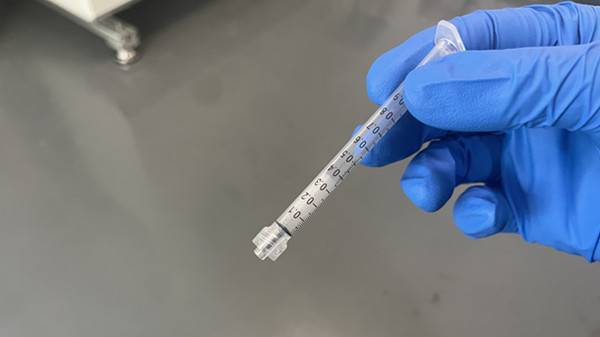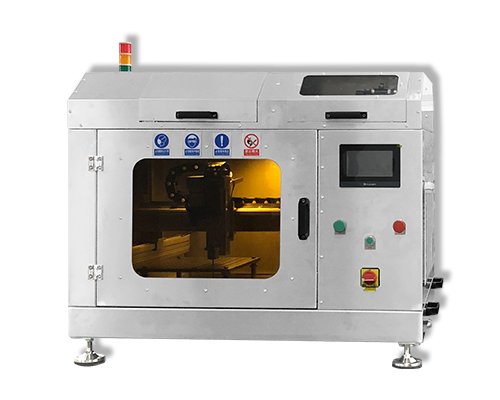Spraying Lithium Heparin
1. Characteristics and application background of lithium heparin
- Characteristics: Lithium heparin is an anticoagulant that can bind to antithrombin III and enhance its inhibitory effect on coagulation factors IIa, Xa, IXa, XIa and XIIa, thereby effectively preventing blood coagulation. In the medical field, lithium heparin is widely used in blood sample collection and coating of certain medical devices to reduce the risk of thrombosis.
- Application background: Spraying lithium heparin on medical devices such as guidewires is mainly to improve the blood compatibility of the device, especially during intravascular interventional operations, to reduce the coagulation activity on the surface of the device, reduce the potential risk of thrombosis, and ensure the safety of the surgical process and the normal use of the device in the body.
2. Preparation for spraying lithium heparin
- Material preparation:
– Preparation of lithium heparin solution: It is necessary to accurately prepare a lithium heparin solution of appropriate concentration. The selection of concentration should take into account factors such as the purpose of the guidewire and the expected effect of the coating. Generally speaking, the concentration of the solution ranges from 10 to 1000 IU/mL (international units/ml), and the specific concentration can be determined according to actual experiments and clinical needs. When preparing the solution, use high-purity lithium heparin raw materials and ensure that they are completely dissolved in appropriate solvents. Commonly used solvents include physiological saline, phosphate buffered saline (PBS), etc.
– Guidewire pretreatment: The surface of the guidewire needs to be cleaned and activated to enhance the adhesion of the lithium heparin coating. The cleaning process can use organic solvents (such as ethanol, acetone) to remove oil and impurities on the surface, and then rinse with deionized water. Activation treatment can be carried out by chemical methods (such as using specific surfactants) or physical methods (such as plasma treatment) to produce some active groups on the surface of the guidewire, which is conducive to the adsorption and binding of lithium heparin. - Equipment preparation:
– Spraying equipment selection: Select appropriate spraying equipment according to the size and shape of the guidewire and the size of the production batch. For small laboratory research or the preparation of a small number of special guidewires, a manual precision spray gun may be an option; for large-scale industrial production, an automated spray production line, such as equipment with precision nozzles and automatic feeding devices, is more suitable.
– Parameter setting: Before spraying, the parameters of the spray equipment need to be set. The main parameters include spray pressure, flow rate, spray distance and spray gun movement speed. The spray pressure is generally controlled between 0.1 – 0.5MPa, and the flow rate is adjusted according to the size of the guidewire and the coating thickness requirements, usually between 0.1 – 10mL/min. The spray distance is kept at about 10 – 30cm, and the spray gun movement speed should be uniform to ensure the uniformity of the coating, generally between 1 – 10cm/s.
3. Key points of process control for spraying lithium heparin
- Uniform spraying: During the spraying process, ensure that the lithium heparin solution is evenly covered on the surface of the guidewire. This requires maintaining the relative position and movement speed between the spray gun and the guidewire. This can be achieved through automated spraying equipment or manual control by skilled operators. For the complex shape parts of the guidewire, such as the bends and tips, special attention should be paid to the uniformity of the spraying. It may be necessary to adjust the spraying angle or use multiple spraying methods.
- Environmental control: The temperature and humidity of the spraying environment also affect the quality of the coating. It is generally recommended to spray in an environment with a temperature of 20-25℃ and a relative humidity of 40-60%. Too high a temperature may cause the solvent to evaporate too quickly, making the lithium heparin coating uneven; too high a humidity may cause the coating to absorb too much water, affecting its performance.
- Avoid pollution: The entire spraying process should be carried out in a clean environment to avoid dust, microorganisms and other impurities from mixing into the lithium heparin coating. The spraying equipment and guidewire must be strictly cleaned and disinfected before spraying.
Ultrasonic spraying is an advanced spraying technology, and its application in the spraying of lithium heparin has many advantages. Ultrasonic spraying of lithium heparin is an advanced spraying technology with the advantages of good spraying uniformity, material saving, and strong controllability. It has broad application prospects in medical device manufacturing, laboratory testing, biopharmaceuticals and other fields.
4. Advantages of ultrasonic spraying of lithium heparin
- Precise control of coating thickness: Ultrasonic spraying technology can accurately control the spraying amount and coating thickness of lithium heparin, ensuring that each sample container can obtain a uniform and consistent anticoagulant coating, thereby improving the accuracy of the test results.
- Improve production efficiency: Compared with traditional manual smearing or dipping methods, ultrasonic spraying technology can achieve automated production and greatly improve production efficiency.
Reduce material waste: Since ultrasonic spraying technology can accurately control the spraying amount, it can reduce the waste of lithium heparin and reduce production costs. - Environmentally friendly and pollution-free: No harmful gases and waste are generated during the ultrasonic spraying process, and there is no pollution to the environment.
5. Application scenarios of ultrasonic spraying of lithium heparin
- Medical device manufacturing: In the production process of medical devices such as blood collection tubes and infusion tubes, the use of ultrasonic spraying technology to spray lithium heparin can improve the anticoagulant performance of the product and ensure the safety and reliability of the medical process.
- Laboratory testing: In clinical laboratories, the use of sample containers sprayed with lithium heparin can effectively prevent blood coagulation and improve the accuracy of test results.
- Biopharmaceuticals: In the field of biopharmaceuticals, ultrasonic spraying of lithium heparin can be used to prepare drug sustained-release systems to improve drug stability and bioavailability.
About Cheersonic
Cheersonic is the leading developer and manufacturer of ultrasonic coating systems for applying precise, thin film coatings to protect, strengthen or smooth surfaces on parts and components for the microelectronics/electronics, alternative energy, medical and industrial markets, including specialized glass applications in construction and automotive.
Our coating solutions are environmentally-friendly, efficient and highly reliable, and enable dramatic reductions in overspray, savings in raw material, water and energy usage and provide improved process repeatability, transfer efficiency, high uniformity and reduced emissions.
Chinese Website: Cheersonic Provides Professional Coating Solutions



